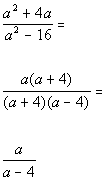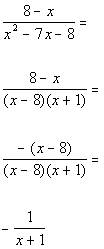

![]()
So to find what values we need to exclude, think of what value(s) of x,
if any, would cause the denominator to be 0.
Since 0 would make the first factor in the denominator 0, then 0 would have to be excluded.
Since 4 would make the second factor in the denominator 0, then 4 would also have to be excluded.
![]()
AND

*Factor
the GCF in the num. and
*Factor
the diff. of squares in the den.
*Divide out the common factor of (a + 4)
*Rational expression simplified
Looking at the denominator a - 4, I would say it would have to be a = 4. Don't you agree?
4 would be our excluded value.
![]()
AND

*Factor
the trinomial in the den.
*Factor out a -1 from (8 - x)
*Divide out the common factor of (x - 8)
*Rational expression simplified
To find the value(s) needed to be excluded from the domain, we need to ask ourselves, what value(s) of x would cause our denominator to be 0?
Looking at the denominator x + 1, I would say it would have to be x = -1. Don't you agree?
-1 would be our excluded value.
Last revised on Dec. 14, 2009 by Kim Seward.
All contents copyright (C) 2002 - 2010, WTAMU and Kim Seward. All rights reserved.